Coat Color Genetics
You can also see the different colors as they grow on this page.
To date, there are at least ten known loci that control coat color in gerbils; each locus controls a different trait. Each of these loci has a dominant allele, that usually represents the form of the trait commonly found in the wild, and at least one recessive allele, representing a less common form of the trait. The eight loci discussed on this page are: A, C, D, E, P, Uw, Sp, and Re. I will also touch on Steel-factor, which is a different sort of locus. The loci not discussed include the Semi-Dominant Lethal Spotting and Wavy mutations, which are not known to be present in the USA at this point.
To understand how these loci work, it is necessary to know how color is structured on the hair.

B: The middle band is a golden brown. Because of the way the individual hairs of the coat overlap, this middle band is the most visible, and contributes most to the perceived overall color.
C: The tip of the hair is black, which gives rise to "ticking", the stippled appearance of colors such as Agouti and Nutmeg.
This gray-brown-black pattern causes the wild-colored coat to appear a dark brown.
Navigation
| A-locus | C-locus | D-locus | E-locus | P-locus | Uw-locus | Sp-locus | Re-locus | Steel-factor |
Mottled Modifiers and Steel-factor
We talk about Mottled modifiers all the time, but what really is a modifier? To understand modifiers, first you need to understand the difference between qualitative and quantitative traits. Qualitative traits are traits that are simply "off" or "on"; the animal either has a "quality", or they don't. Such traits are typically controlled by a single locus, which is likewise either "off" (wild-type) or "on" (mutant). When we think of gerbil genetics, we think of qualitative traits. For example, with white-bellied vs. self colors, a gerbil is either A- (off) or aa (on). These qualitative traits are the ones governed by the basic rules of genetics (Mendelian inheritance).
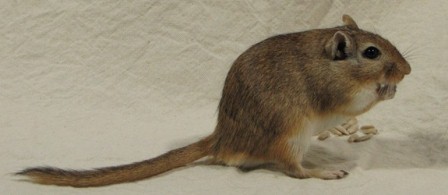
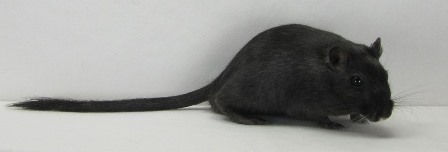
The two outcomes of a qualitative trait
In contrast, quantitative traits are traits that have a wide range of expression, which can be described as a numerical "quantity". The length of a gerbil from nose to tail-tip would be a quantitative trait. So would the shape of a gerbil's eyes. Eye shape might not immediately translate into a number like length does, but you could rank the shape to generate a number - say "0" for very narrow, "5" for almond-shaped, and "10" for very round. These quantitative traits are usually polygenetic: controlled by many genes working together, rather than just one. The more of these polygenes that are "turned on", the more strongly the trait is expressed.
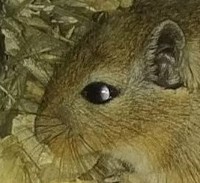
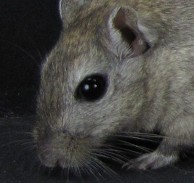
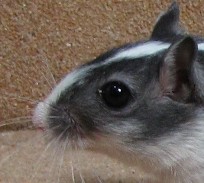
Just some of the outcomes of a quantitative trait
When a collection of polygenes works together to modify the expression of a qualitative trait, they're known as modifier genes, or just modifiers. Modifiers are why we see such a wide range of spotting patterns all produced by the same Dominant Spotting mutation. On their own, we can still see these modifiers at work: the more modifiers that are "turned on", the more white that self gerbils will have on the chin and forepaws. In extreme cases, we have Tuxedos, where there are so many modifiers accumulated that a gerbil can almost look Spotted, without having the Dom Spot mutation at all!
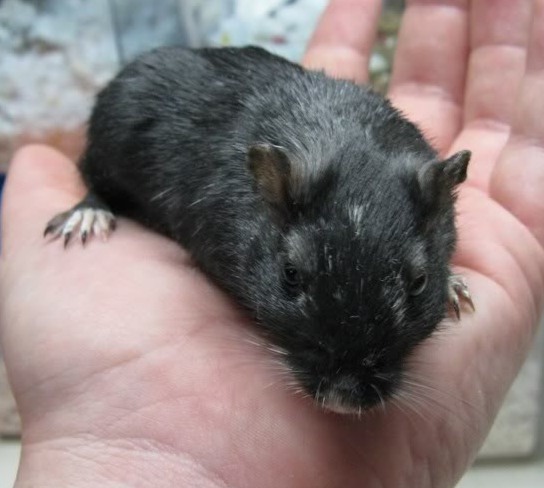
Black Tuxedo: no Sp but many modifiers
But it's when these "Mottled modifiers" are combined with the Dom Spot mutation that the effects are most apparent. With very few modifiers, Dom Spot gerbils have very little white, sometimes missing typical spot locations entirely. This pattern is sometimes called Mini-Spot, and often comes from lines of self gerbils that have been selected for as little paw and chin white as possible - which is, in reality, selecting for as few Mottled modifiers as possible.
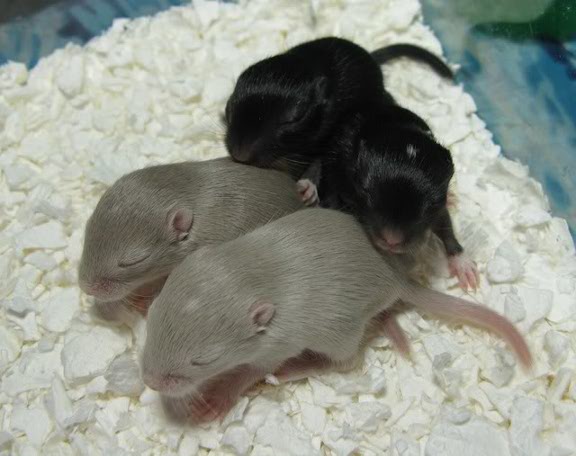
Mini-Spot: Sp+, but with few modifiers
As the number of activated Mottled modifiers increases, we see the amount of white on Dom Spot gerbils increase - going from Mini-Spot all the way to High White. The gerbil community has chosen certain amounts/arrangements of white to name and standardize, but it's all one big sliding scale.
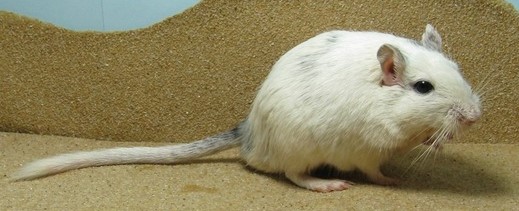
Black High White: both Sp+ and many modifiers
Steel, or Steel-factor, was only identified relatively recently, and there's still some confusion about exactly how it works. Steel-factor causes a lightened coat, with pigment often distributed unevenly along the hair shafts, as well as stray white hairs, especially on the tail and hind paws.
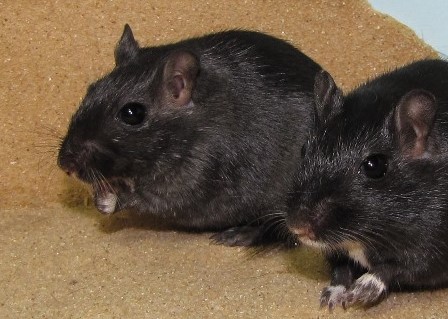
Both Black gerbils have Steel-factor, though the left one has more fading
Steel-factor was initially assumed to be a simple dominant or recessive mutation like all the other color mutations we deal with in gerbils. However, no simple inheritance pattern was ever displayed. This means that Steel-factor is a quantitative trait, not a qualitative one!
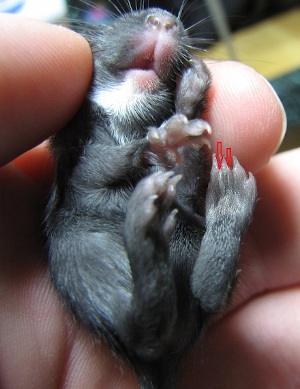
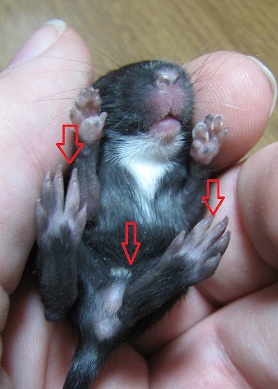
Low-expression Steel-factor and high-expression Steel-factor
When combined with Dom Spot, Steel-factor adds white flecking somewhat randomly over the whole body in addition to the areas typically affected by Dom Spot, as well as making the edges of any solid white patches look ragged and uneven. Given what we've just discussed, this means the Steel-factor polygenes are modifiers of Dom Spot - a separate set of modifiers from our traditional Mottled modifiers.
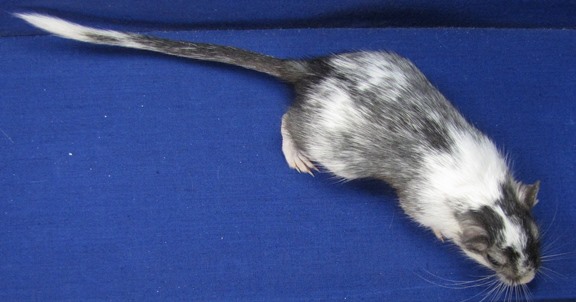
A Mottled Black with typical Steel-factor flecking
On one end of the Spotting spectrum, it can yield some very attractive Mottled patterns; on the other, it can create a pattern known as Roan. Roan gerbils have little white in the "normal" distribution caused by Dominant Spot, instead having white hairs mixed evenly throughout the coat in a way that visually mimics roaning in other species.
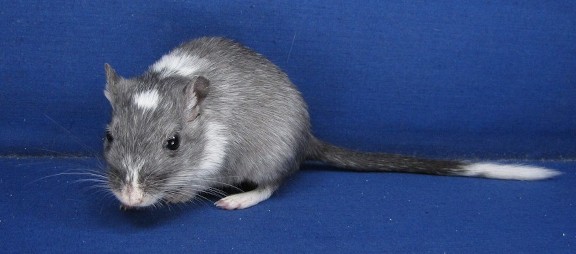
Black Roan: has Sp+, low Mottled modifiers, and high Steel-factor modifiers
Similar to true Roan (which is a different genetic mechanism altogether), the proportion of white hairs increases with age. Thus, a gerbil which looks simply Spotted as a pup may "roan out" over time to produce an exemplary show-standard Roan. One of the most reliable (but not foolproof) signs as to whether a pup will roan out is the presence of stray white hairs in the colored portion of the tail, especially when combined with a Classic Spot or low-white Pied pattern from Dom Spot. (Gerbils that have only Dom Spot will typically lack white flecking in the tail until they get into the higher-white Pied patterns.)
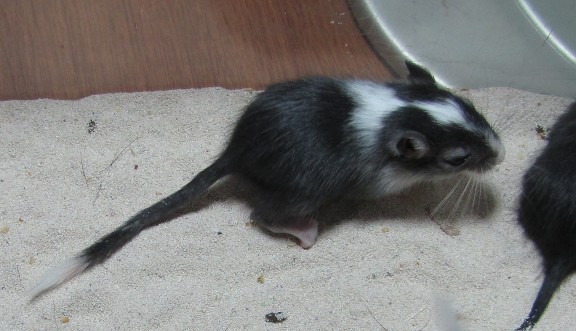
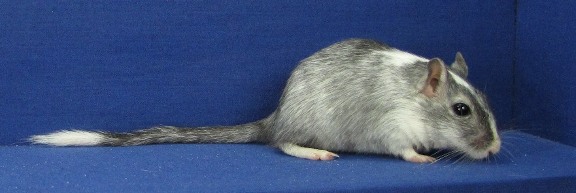
SStar's Blue Mountain Sage, Black Roan at 5 weeks old and 2 years old
Since what we have been calling Steel-factor is not the same as the qualitative trait Steel in mice, we should not use the symbol Sl. I propose using the symbol Sfm (Steel-factor modifiers) for the gerbil quantitative trait locus, because this symbol is not currently used for any mouse locus. Being a quantitative trait locus, Sfm is not a simple recessive or dominant, so the locus symbol can simply be added to the genotype to signify the presence of a visible amount of Steel-factor modifiers.
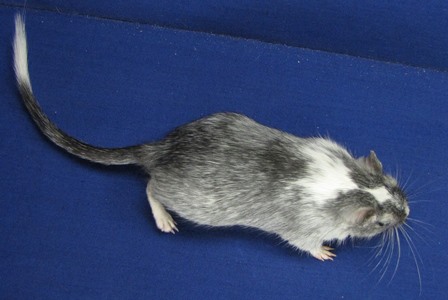
Black Roan: aa C- D- E- P- Uw- Sp+ Sfm
Further Reading
2. Studies on Spotting Patterns II. Analysis of Variegated Spotting in the House Mouse
3. Quantitative Trait Loci That Modify the Severity of Spotting in piebald Mice (PDF)
4. Modifier Genes and the Plasticity of Genetic Networks in Mice
5. Previous articles on Steel-factor in gerbils:
